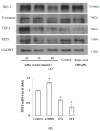Inhibitory effects of adlay extract on melanin production and cellular oxygen stress in B16F10 melanoma cells
- PMID: 25244016
- PMCID: PMC4200782
- DOI: 10.3390/ijms150916665
Inhibitory effects of adlay extract on melanin production and cellular oxygen stress in B16F10 melanoma cells
Abstract
The aim of this study was to determine the effects of adlay extract on melanin production and the antioxidant characteristics of the extract. The seeds were extracted by the supercritical fluid CO2 extraction (SFE) method. The effect of adlay extract on melanin production was evaluated using mushroom tyrosinase activity assay, intracellular tyrosinase activity, antioxidant properties and melanin content. Those assays were performed spectrophotometrically. In addition, the expression of melanogenesis-related proteins was determined by western blotting. The results revealed that the adlay extract suppressed intracellular tyrosinase activity and decreased the amount of melanin in B16F10 cells. The adlay extract decreased the expression of microphthalmia-associated transcription factor (MITF), tyrosinase, tyrosinase related protein-1 (TRP-1) and tyrosinase related protein-2 (TRP-2). The extract also exhibited antioxidant characteristics such as free radical scavenging capacity and reducing power. It effectively decreased intracellular reactive oxygen species (ROS) levels in B16F10 cells. We concluded that the adlay extract inhibits melanin production by down-regulation of MITF, tyrosinase, TRP-1 and TRP-2. The antioxidant properties of the extract may also contribute to the inhibition of melanogenesis. The adlay extract can therefore be applied as an inhibitor of melanogenesis and could also act as a natural antioxidant in skin care products.
Figures



Similar articles
-
Inhibition of melanogenesis and antioxidant properties of Magnolia grandiflora L. flower extract.BMC Complement Altern Med. 2012 Jun 6;12:72. doi: 10.1186/1472-6882-12-72. BMC Complement Altern Med. 2012. PMID: 22672352 Free PMC article.
-
Ethyl acetate extract from Panax ginseng C.A. Meyer and its main constituents inhibit α-melanocyte-stimulating hormone-induced melanogenesis by suppressing oxidative stress in B16 mouse melanoma cells.J Ethnopharmacol. 2017 Aug 17;208:149-156. doi: 10.1016/j.jep.2017.07.004. Epub 2017 Jul 8. J Ethnopharmacol. 2017. PMID: 28689798
-
Melanogenesis inhibitory effect of aerial part of Pueraria thunbergiana in vitro and in vivo.Arch Dermatol Res. 2015 Jan;307(1):57-72. doi: 10.1007/s00403-014-1489-z. Epub 2014 Jul 26. Arch Dermatol Res. 2015. PMID: 25063049 Free PMC article.
-
Skin whitening agents: medicinal chemistry perspective of tyrosinase inhibitors.J Enzyme Inhib Med Chem. 2017 Dec;32(1):403-425. doi: 10.1080/14756366.2016.1256882. J Enzyme Inhib Med Chem. 2017. PMID: 28097901 Free PMC article. Review.
-
Actional Mechanisms of Active Ingredients in Functional Food Adlay for Human Health.Molecules. 2022 Jul 27;27(15):4808. doi: 10.3390/molecules27154808. Molecules. 2022. PMID: 35956759 Free PMC article. Review.
Cited by
-
Nanoemulsified adlay bran oil reduces tyrosinase activity and melanin synthesis in B16F10 cells and zebrafish.Food Sci Nutr. 2019 Sep 5;7(10):3216-3223. doi: 10.1002/fsn3.1176. eCollection 2019 Oct. Food Sci Nutr. 2019. PMID: 31660135 Free PMC article.
-
The neuroprotective effect of traditional Chinese medicinal plants-A critical review.Acta Pharm Sin B. 2023 Aug;13(8):3208-3237. doi: 10.1016/j.apsb.2023.06.009. Epub 2023 Jun 20. Acta Pharm Sin B. 2023. PMID: 37655317 Free PMC article. Review.
-
Identification of Sitogluside as a Potential Skin-Pigmentation-Reducing Agent through Network Pharmacology.Oxid Med Cell Longev. 2021 Sep 23;2021:4883398. doi: 10.1155/2021/4883398. eCollection 2021. Oxid Med Cell Longev. 2021. PMID: 34603597 Free PMC article.
-
Inhibitory Effect of Dried Pomegranate Concentration Powder on Melanogenesis in B16F10 Melanoma Cells; Involvement of p38 and PKA Signaling Pathways.Int J Mol Sci. 2015 Oct 13;16(10):24219-42. doi: 10.3390/ijms161024219. Int J Mol Sci. 2015. PMID: 26473849 Free PMC article.
-
The Modulation of Melanogenesis in B16 Cells Upon Treatment with Plant Extracts and Isolated Plant Compounds.Molecules. 2022 Jul 7;27(14):4360. doi: 10.3390/molecules27144360. Molecules. 2022. PMID: 35889231 Free PMC article. Review.
References
-
- Garcia A., Fulton J.E. The combination of glycolic acid and hydroquinone or kojic acid for the treatment of melasma and related conditions. Dermatol. Surg. 1996;22:443–447. - PubMed
Publication types
MeSH terms
Substances
LinkOut - more resources
Full Text Sources
Other Literature Sources
Medical
Research Materials

